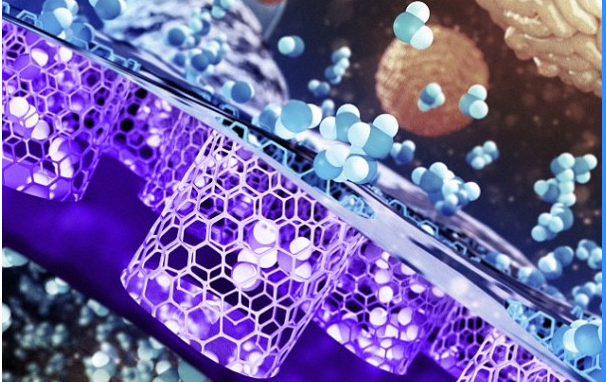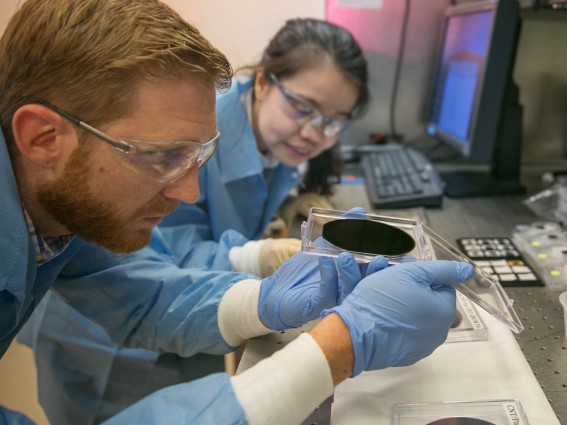据英国《每日邮报》8月4日报道,近日,美国劳伦斯利物莫国家实验室研制出一种新式军装,可以作为士兵的第二皮肤,帮助他们远离细菌、病毒和各种化学药剂。新式军装采用碳纳米管材料,不仅透气性好,而且可以防止病毒和细菌侵入身体。

军事人员在污染严重的环境中执行任务时,常常会感到浑身发热,四肢无力,这时能够正常呼吸十分重要,碳纳米管材料可以轻松做到这一点。此外,研究者还研制出一种活跃的高分子膜,可与微小的碳纳米管相结合,阻止军人体内水分流失。

研究负责人布伊说:“我们通过实验证明,这些细胞膜可以输送的水汽远远超过那些商业透气材料。尽管碳纳米管仅有数纳米宽,但它的透气性却非常好。”此外,研究人员还表示这种材料在10年之后有可能成为未来智能服饰的关键成分,用以抵抗环境化学危害。(实习编译:任艳阳 审稿:李宗泽)上述内容转自环球科技,仅供参考学习。
小编补充技术参考文献:Carbon Nanotubes: Ultrabreathable and Protective Membranes with Sub-5 nm Carbon Nanotube Pores (Adv. Mater. 28/2016),Volume 28, Issue 28 July 27, 2016 Page 6020
A flexible membrane with sub-5 nm single-walled carbon nanotube (SWNT) pores is developed by F. Fornasiero and co-workers, as described on page 5871, for application as a key component of protective, yet breathable fabrics. The SWNTs are shown to enable exceptionally fast transport of water vapor under a concentration driving force. Thus, membranes having SWNTs as moisture-conductive pores feature outstanding breathability and provide a high degree of protection from biological threats by size exclusion.
以下是该机构的解读报道:
‘Second skin’ uniform protects soldiers from biological and chemical agents in the field
In work that aims to protect soldiers from biological and chemical threats, a team of Lawrence Livermore National Laboratory scientists has created a material that is highly breathable yet protective from biological agents.
This material is the first key component of futuristic smart uniforms that also will respond to and protect from environmental chemical hazards. The research appears in the July 27 edition of the journal, Advanced Materials (link is external).
High breathability is a critical requirement for protective clothing to prevent heat-stress and exhaustion when military personnel are engaged in missions in contaminated environments. Current protective military uniforms are based on heavyweight full-barrier protection or permeable adsorptive protective garments that cannot meet the critical demand of simultaneous high comfort and protection, and provide a passive rather than active response to an environmental threat.
The LLNL team fabricated flexible polymeric membranes with aligned carbon nanotube (CNT) channels as moisture conductive pores. The size of these pores (less than 5 nanometers, nm) is 5,000 times smaller than the width of a human hair.
Ngoc Bui demonstrates the flexibility of a carbon nanotube membrane.
“We demonstrated that these membranes provide rates of water vapor transport that surpass those of commercial breathable fabrics like GoreTex, even though the CNT pores are only a few nanometers wide,” said Ngoc Bui, the lead author of the paper.
To provide high breathability, the new composite material takes advantage of the unique transport properties of carbon nanotube pores. By quantifying the membrane permeability to water vapor, the team found for the first time that, when a concentration gradient is used as a driving force, CNT nanochannels can sustain gas-transport rates exceeding that of a well-known diffusion theory by more than one order of magnitude.
Lawrence Livermore scientists are developing a flexible membrane with sub-5 nanometer single-walled carbon nanotube pores – a key component of protective, yet breathable fabrics. Image by Ryan Chen/LLNL.
These membranes also provide protection from biological agents due to their very small pore size — less than 5 nanometers (nm) wide. Biological threats like bacteria or viruses are much larger and typically more than 10-nm in size. Performed tests demonstrated that the CNT membranes repelled Dengue virus from aqueous solutions during filtration tests. This confirms that LLNL-developed CNT membranes provide effective protection from biological threats by size exclusion rather than by merely preventing wetting.
Furthermore, the results show that CNT pores combine high breathability and bio-protection in a single functional material.
However, chemical agents are much smaller in size and require the membrane pores to be able to react to block the threat. To encode the membrane with a smart and dynamic response to small chemical hazards, LLNL scientists and collaborators are surface modifying these prototype carbon nanotube membranes with chemical-threat-responsive functional groups. These functional groups will sense and block the threat like gatekeepers on the pore entrance. A second response scheme also is in development — similar to how living skin peels off when challenged with dangerous external factors. The fabric will exfoliate upon reaction with the chemical agent.
“The material will be like a smart second skin that responds to the environment,” said Kuang Jen Wu, leader of LLNL’s Biosecurity & Biosciences Group. “In this way, the fabric will be able to block chemical agents such as sulfur mustard (blister agent), GD and VX nerve agents, toxins such as staphylococcal enterotoxin and biological spores such as anthrax.”
Current work is directed toward designing this multifunctional material to undergo a rapid transition from the breathable state to the protective state.
“These responsive membranes are expected to be particularly effective in mitigating a physiological burden because a less breathable but protective state can be actuated locally and only when needed,” said Francesco Fornasiero, LLNL’s principal investigator of the project.
The new uniforms could be deployed in the field in less than 10 years.
“The goal of this science and technology program is to develop a focused, innovative technological solution for future chemical biological defense protective clothing,” said Tracee Whitfield, the DTRA science and technology manager for the Dynamic Multifunctional Material for a Second Skin Program. “Swatch-level evaluations will occur in early 2018 to demonstrate the concept of ‘second skin,’ a major milestone that is a key step in the maturation of this technology.”
The work is funded by the Chemical and Biological Technologies Department of the Defense Threat Reduction Agency (link is external) (DTRA) in the “Dynamic Multifunctional Materials for a Second Skin D[MS]2” program, and by the Laboratory Directed Research and Development (LDRD) program.
Other researchers contributing to this work include Eric Meshot, Jose Pena, Sangil Kim and Phillip Gibson (Natick Soldier Research Development and Engineering Center).
资料来源:Lawrence Livermore National Laboratory,仅供学习。